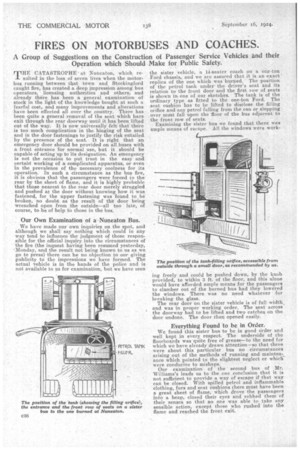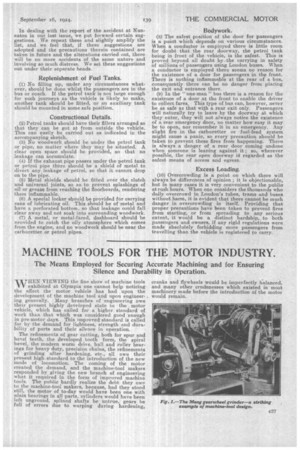FIRES ON MOTORBUSES AND COACHES.
Page 16

Page 17

If you've noticed an error in this article please click here to report it so we can fix it.
A Group of Suggestions on the Construction of Passenger Service Vehicles and their Operation which Should Make for Public Safety.
THE CATASTROPHE at Nuneaton, which restilted in the loss of seven lives when the motorbus running between that town and Stockingford caught fire, has created a deep impression among bus operators, licensing authorities and others, and already there has been a general examination of stock in the light of the knowledge bought at such a fearful cost, and many improvements and alterations have been effected all over the coiintry. There has been quite a general removal of the seat -which bars exit through the rear doorway until it has been lifted out of the way. It is now universally felt that there is too much complication in the. hinging of the seat and in the door fastenings to justify the risk entailed by the presence of the scat. It is right that an emergency door should be provided on all buses with a front entrance for normal use, but it should be capable of acting up to its designation. An emergency is not the occasion to put trust in the easy and certain working of a complicated apparatus, or even in the prevalence of the necessary coolness for its operation. In such a circumstance as the bus fire, it is obvious that the passengers were forced to the
• rear by the sheet of flame, and it is highly probable that those nearest to the rear door merely struggled and pushed at the door without knowing how it was fastened, for the upper fastening was found to be broken, no doubt as the result of the door being wrenched open from the outside—all too late, of course, to be of help to those in the bus.
Our Own Examination of a .Nuneaton Bus.
We have made our own inquiries on the spot, and although we shall say nothing which could in any way tend to influence the judgment of those responsible for the official inquiry into the circumstances of the fire (the inquest having been resumed yesterday, 'Monday, and the result not being known to us as we go to press) there can be no ob)ection to our giving publicity to the impressions we have formed. The actual vehicle is in the hands of the police and is not available to us for examination, but we have seen
the sister vehicle, a 14-seater coach on a one-ton • Ford chassis, and we are assured that it is an exact ' replica of the one which was burned. The position of the petrol tank under the driver's seat and its relation to the front door and the first row of seats is shown in. one of our sketches. The tank is of the ordinary type as fitted to the one-ton Ford. The seat cushion has to be lifted to disclose the filling orifice and any petrol falling from the can or slopping over must fall upon the-floor of the bug adjacent to the front. row of seats.
Examining the sister bus we found that there was ample means of escape. All the windows were work ing freely and could be pushed down, by the knob provided, to within 3 ft. of the floor, and this alone would have afforded ample means for the passengers to clamber out of the burned bus had they lowered the windows. There was no need whatever for breaking the glass. The rear door on the sister vehicle is of full width_ and was in proper working order. The seat across the doorway had to be lifted and two catches on the door undone. The door then opened easily.
Everything Found to be in Order.
We found this sister bus to be in good Order and well kept in every respect. The underside of the floorboards was quite free of grease—to the need for which we have already drawn attention—so that there were about this particular bus no circumstances arising out of the methods of running and maintenance which pointed to the slightest neglect or which' were conducive to mishaps. Our examination of the second bus of Mr. Williams's leads us to the one conclusion that it is not sufficient to provide a way of escape if that way can be closed. With spilled petrol and inflammable clothing, furs and seat cushions there must have been a great sheet of flame, which drove the passengers into a heap, closed their eyes and robbed them of their senses so that no one was able to take any sensible action, except those who rushed into the flame and reached the front exit. In dealing with the report of the accident at Nuneaton in our last issue, we put forward certain suggestions. We repeat these and slightly amplify the list, and we feel that, if these suggestions are adopted and the precautions therein contained are taken in future and the alterations carried out, there will be no more accidents of the same nature and involving so much distress. We set these suggestions out under their separate heads.
Replenishment of Fuel Tanks.
(1) No filling up, under any circumstances whatever, should be done whilst the passengers are in the bus or coach. If the petrol tank is not large enough for such journeys as the vehicle is likely to make, another tank should be fitted, or an auxiliary tank should be mounted in some safe position.
Constructional Details.
(5)Petrol tanks should have their fillers arranged so that they can be got at from outside the vehicle. This can easily be carried out as indicated in the accompanying sketch. (3) No woodwork should be under the petrol tank or pipe, no matter where they may he situated. A clear open space should be provided, so that no leakage can accumulate. (4) If the exhaust pipe passes under the petrol tank or petrol pipe there should be a shield of metal to divert any leakage of petrol, so that it cannot drop on to the pipe. . (5) Metal shields should be fitted over the clutch and universal joints, so as to prevent splashings of oil or grease from reaching the floorboards, rendering them inflammable, (6) A special locker should be provided for carrying cans of lubricating oil. This should be of metal and have a perforated bottom, so that leakage could fall clear away and not soak into surrounding woodwork. (7) A metal, or metal-faced, dashboard should be provided to catch the oily atmosphere which comes from the engine, and no woodwork should be near the carburetter or petrol pipes.
Bodywork.
(8) The safest position of the door for passengers is a point which depends on various circumstances. When a conductor is employed there is little room for doubt that the rear doorway, the petrol tank being in front of the vehicle, is the safest. This is proved beyond all doubt by. the carrying in safety of millions of passengers using London buses. When a conductor is employed there seems no reason for the existence of a door for passengers in the front. There is nothing inflammable at the rear of a bus, consequently there can be no danger from placing the exit and entrance there.
(9) In the "one-man " bus there is a reason for the existence of a door at the front to enable the driver to collect fares. This type of bus can, however, never be as safe as that with a rear exit only. Passengers will naturally try to leave by the doorway at which they enter, they will not always notice the existence of a rear emergency door, no matter how easy it may be to open, nor remember it in an emergency. Any slight fire in the carburetter or fuel-feed system might cause a panic, so every precaution should be taken to prevent these fires from happening. There is always a danger of a rear door coming undone when someone is leaning against it ; so, wherever possible, the rear open doorway i regarded as the safest means of access and egress.
Excess Loading.
(10) Overcrowding is a point on which there will always be differences of opinion ; it is objectionable, but in many cases it is very convenient to the public, at rush hours. When one considers the thousands who daily overcrowd in London's tubes, trams and buses without harm, it is evident that there cannot be much danger in overcrowding in itself. Providing that proper precautions have been taken to prevent fires from starting, or from spreading to any serious extent, it would be a distinct hardship, to both passengers and owners, if any rigid regulations were made absolutely forbidding more passengers from travelling than the vehicle is registered to carry.




























